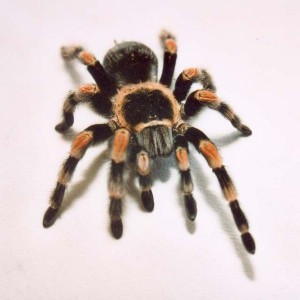A female Mexican red-knee tarantula

Kevin Charles Redmon’s piece Tuesday on how spiders so thoroughly put the fear of God into grasshoppers that the grasshoppers’ actual body chemistry changes rang true for me, an admitted arachnophobe.
As Kevin noted, the spiders’ mouths had been glued shut—you’ll have to go to his story to see how—but the grasshoppers were still plenty scared. I’m the same way—I rarely inspect that black widow’s mandibles for Elmer’s before sfreaking out. It may not make sense to be afraid, and yet …
All of which puts me in mind of research that came out last year in the Journal of Anxiety Disorders examining the nexus between fear and perception. The paper, by psychologist Michael W. Vasey and his peers at The Ohio State University, took 57 spider-phobic Ohioans (80 percent were female) and had them “interact” with five separate Chaco golden knee or a Mexican red-knee tarantulas. After covering up the tank containing these orthopedically splendid critters (and scraping the human participants off the lab ceiling), the researchers asked how big the various spiders were.
As you, or any nearby grasshopper, might guess, the humans tended to describe the spiders are much larger than they actually were. (That wasn’t necessarily obvious before the study, though, since past research has found we tend to pay more attention to “emotional stimuli” which in turn suggests we might come up with a more accurate size estimate.)
While the academics see understanding and sharing this magnification as having therapeutic value in treating phobias, I can’t help but see it as a reminder that in dealing with any panicked populace, they tend to exaggerate the threat. And that’s not a bad thought to scribble on a Post-It note for future policy discussions, with or without bugs.




